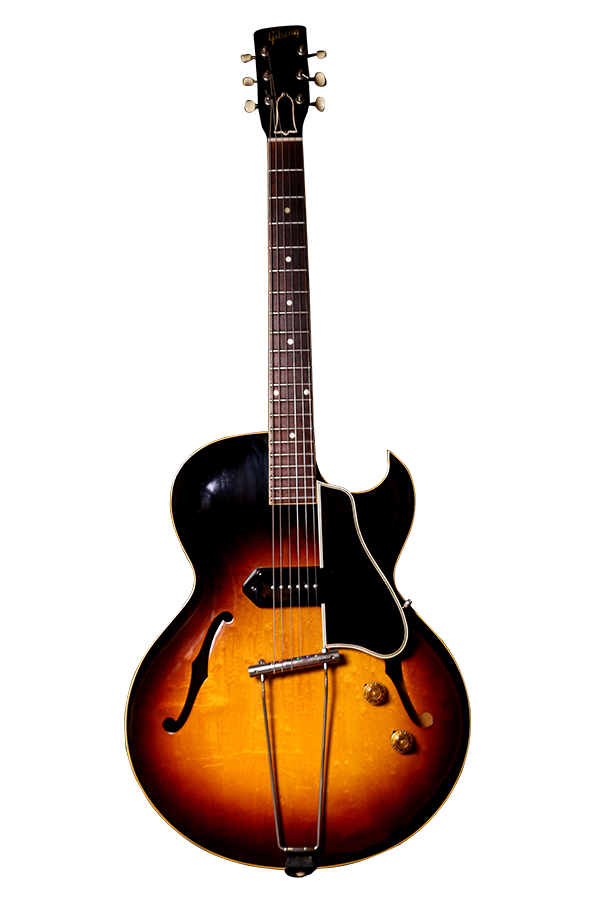Silver Lake Vintage Guitars
1959 Gibson ES 225
Often overlooked and undervalued, the Gibson ES-225T was a game changer in the evolution of electric guitar design.
Introduced in 1955, the ES-225T was the first thinline hollow body Electro Spanish (ES) guitar to feature in the Gibson catalogue. It was also the first Gibson guitar to feature a single P90 pickup placed halfway between the bridge and fingerboard.
The concept of the thinline semi hollow electric guitars pioneered by Gibson led to some of the most significant developments in guitar design in the 1950s. The Gibson Byrdland and ES-350T followed shortly after the introduction of the ES-225T, leading the way for the classic ES-335TD, 345TD, 355TDC and 330TD models which would revolutionise music.
Driven by competition and the need to anticipate changing tastes and styles in music, American guitar manufacturers were constantly trying to develop new models. Competition was fierce. Consider for example the spat between Gibson and Epiphone in the 1940’s when Gibson put on the headstock of their guitars “Only a Gibson is good enough”. Epiphone replied, “when good enough is not good enough”.
The major American manufacturers were constantly on the lookout for the next big thing.
Leo Fender when developing new ideas and models would send out early prototypes to well-known musicians, large retailers, musician guilds, and federations to get feedback before putting the guitar into production.
Back to the humble ES-225T and why its introduction in 1955 was so significant.
Gibson took the body style and construction of the full bodied ES-175 with a laminated maple top and sides, Florentine cutaway, rosewood fingerboard and added Les Paul’s combination bridge/trapeze tailpiece from the early 1952/3 Les Paul Standard and ES-295. But, all-important to the new ES-225T was the new slimmer body at only 1 ¾ inches compared to the 3 3/8 inches of the ES-175. This new concept of the slimmer body style was to herald a whole new breed of guitars from Gibson.
(Note: When Les Paul invented his trapeze tailpiece his intention was to create more sustain and a darker tone. Fitted to his new guitar, the Les Paul Standard in 1952, the tailpiece proved unpopular with players who found it got in the way of their hand. However, the trapeze tailpiece is great for slide playing.)
So how did this new thinline guitar come about? Actually, at a Disc Jockey convention in Nashville, in 1955. Gibson, had a booth demonstrating their latest models. Session guitarists Hank Garland and Billy Byrd were invited to attend, and Gibson rep Clarence Havenga asked the two top session players, "What would you like in a guitar that we don't already have?” Hank Garland had already commissioned a guitar from Elmer Stromberg that was about an inch thinner in depth than a conventional archtop. By the time the three had finished brainstorming, a new concept of guitar design was born.
Clarence Havenga, returned to Gibson and rushed into production three new models with the slimmer body: the Byrdland, the ES-350T, and the ES-225T. Unlike its premium priced siblings, the ES-225T was the first to be put into production and targeted at a mass audience. It was incredibly popular and over 2,200 of the new Florentine cutaway ES-225 thinlines were shipped in the first two years of production.
The Gibson ES-225T was in production from 1955 and 1959. The single pickup ES-225T was launched in 1955 followed by the two pickup ES-225TD in 1956. Initially offered only in sunburst finish, natural options (ES-225TN and ES225TDN) became available in 1956 but was produced in significantly smaller quantities making them much rarer variants. Just under 8,000 units of the ES-225T and ES-225TD were shipped up to 1959. A few guitars were shipped in 1959 with separate trapeze-style tailpieces and floating Tune-o-matic bridges.
To conclude: Introduced in 1955, the ES-225 was Gibson’s first production thinline ES hollow body Florentine cutaway guitar. A significant invention which had far reaching influence and development on future models This new versatile thinline design enabled musicians to create music and playing styles never before heard. With the introduction of much more powerful amplifiers like the Fender Bassman (which heavily influenced Jim Marshall’s JTM 45) the world came to enjoy rock music. Before the ES-225 and the introduction of the thinline range, Gibson guitars were considered to be rather “old fashioned”. Fledgling rock and roll, jazz, and Leo Fender’s futuristic sold body guitars heralded a response from Gibson. The birth of the thinline semi acoustic electric guitar introduced the evolution Gibson desired.
